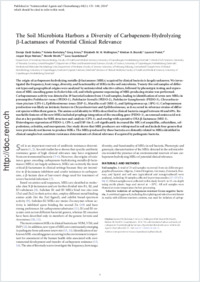The soil microbiota harbors a diversity of carbapenem-hydrolyzing β-lactamases of potential clinical relevance
- Gudeta, Dereje Dadi Department of Veterinary Disease Biology, Faculty of Health and Medical Sciences, University of Copenhagen, Frederiksberg, Denmark
- Bortolaia, Valeria Department of Veterinary Disease Biology, Faculty of Health and Medical Sciences, University of Copenhagen, Frederiksberg, Denmark
- Amos, Greg School of Life Sciences, University of Warwick, Coventry, United Kingdom
- Wellington, Elizabeth M. H. School of Life Sciences, University of Warwick, Coventry, United Kingdom
- Brandt, Kristian K. Department of Plant and Environmental Sciences, Faculty of Science, University of Copenhagen, Frederiksberg, Denmark
- Poirel, Laurent Medical and Molecular Microbiology Unit, Department of Medicine, Faculty of Science, University of Fribourg, Switzerland
- Nielsen, Jesper Boye Department of Clinical Microbiology, University of Copenhagen, Hvidovre Hospital, Hvidovre, Denmark
- Westh, Henrik Department of Clinical Microbiology, University of Copenhagen, Hvidovre Hospital, Hvidovre, Denmark - Institute of Clinical Medicine, Faculty of Health and Medical Sciences, University of Copenhagen, Frederiksberg, Denmark
- Guardabassi, Luca Department of Veterinary Disease Biology, Faculty of Health and Medical Sciences, University of Copenhagen, Frederiksberg, Denmark
-
17.11.2015
Published in:
- Antimicrobial Agents and Chemotherapy. - 2016, vol. 60, no. 1, p. 151–160
English
The origin of carbapenem-hydrolyzing metallo-β-lactamases (MBLs) acquired by clinical bacteria is largely unknown. We investigated the frequency, host range, diversity, and functionality of MBLs in the soil microbiota. Twenty-five soil samples of different types and geographical origins were analyzed by antimicrobial selective culture, followed by phenotypic testing and expression of MBL-encoding genes in Escherichia coli, and whole-genome sequencing of MBL-producing strains was performed. Carbapenemase activity was detected in 29 bacterial isolates from 13 soil samples, leading to identification of seven new MBLs in presumptive Pedobacter roseus (PEDO-1), Pedobacter borealis (PEDO-2), Pedobacter kyungheensis (PEDO-3), Chryseobacterium piscium (CPS-1), Epilithonimonas tenax (ESP-1), Massilia oculi (MSI-1), and Sphingomonas sp. (SPG-1). Carbapenemase production was likely an intrinsic feature in Chryseobacterium and Epilithonimonas, as it occurred in reference strains of different species within these genera. The amino acid identity to MBLs described in clinical bacteria ranged between 40 and 69%. Remarkable features of the new MBLs included prophage integration of the encoding gene (PEDO-1), an unusual amino acid residue at a key position for MBL structure and catalysis (CPS-1), and overlap with a putative OXA β-lactamase (MSI-1). Heterologous expression of PEDO-1, CPS-1, and ESP-1in E. coli significantly increased the MICs of ampicillin, ceftazidime, cefpodoxime, cefoxitin, and meropenem. Our study shows that MBL producers are widespread in soil and include four genera that were previously not known to produce MBLs. The MBLs produced by these bacteria are distantly related to MBLs identified in clinical samples but constitute resistance determinants of clinical relevance if acquired by pathogenic bacteria.
- Faculty
- Faculté des sciences et de médecine
- Department
- Médecine 3ème année
- Language
-
- English
- Classification
- Biological sciences
- License
-
License undefined
- Identifiers
-
- RERO DOC 258959
- DOI 10.1128/AAC.01424-15
- Persistent URL
- https://folia.unifr.ch/unifr/documents/304734
Other files
Statistics
Document views: 89
File downloads:
- pdf: 220
- Supplementary material: 145

